Illustrated Catalogue of Pumps and Pumping Machinery,
1930
| This catalogue covers the larger and heavier duty pumps.
It refers users to their other catalogue for the lighter pumps: "hand
pumps, pitcher pumps, lift and force pumps, yard pumps, farm pumps, deep
well pumps, contractors' pumps, chain pumps, rotary pumps, horse pumps,
fire pumps, ships' pumps, gaswork syphon pumps, colliery syphon pumps,
small treble ram pumps, small power pumps, wind mill pumps, centrifugal
pumps, hydraulic rams, etc..". That list, taken with the types of
pumps shown here, indicate the enormous range of specialist pumps that
the company made. Many of them must have been made to order and stocking
spares must have been quite a problem. It is perhaps surprising
that it seems that it was not until the 1950s that they made a
determined effort to rationalise and generalise their range. |
 |
More than half of the catalogue is occupied by
Cornish steam pumps. This one is the Cornish Direct-Acting
Steam Pump (Bucket Type) Globe Pattern.
As in most cases of Cornish pumps there is a reference to
Evans' and Tonkin's Patents. It is not known that Evans
ever introduced any radical departure in pumps and their
patents were probably for changes to the basic machine. |
| This is the Cornish Compound Steam Pump, described
as being "compounded for the more economical use of steam". |
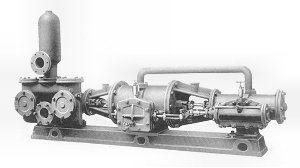 |
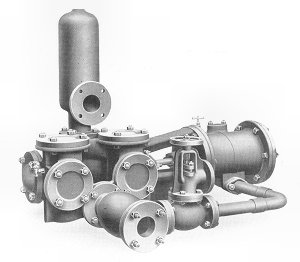 |
This is another Cornish Direct-Acting Steam Pump
but it has Evans' Improved Suction Condenser.
Like all of their pumps, this one comes in various
conformations. In one conformation it is said that it will
pump 39,980 gallons per hour. |
|
 |
Some pumps are horizontal only, some are vertical
only, and some can be mounted either way.
On the left is a Vertical Cornish Direct-Acting Sinking Pump.
Note the ring and chain at the top by which the pump could be
lowered down a shaft to "within suction distance of the water".
On the right is a Cornish Direct-Acting Steam Pump with
vertical cross-tube boiler "mounted on wheels for portability".
|
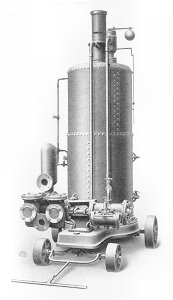 |
| The Portable Cornish Steam Pump and Boiler (Bucket
Type) "designed specially for low lifts, such as emptying mains
and trenches and for irrigation purposes".
This is 1930 but Richard Trevithick would have felt quite at
home with this machine. |
 |
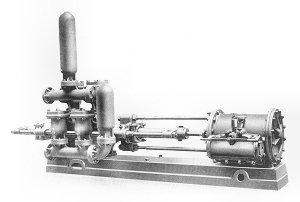 |
The Cornish Double-Acting Steam Pumping Engine
(Outside-Packed Ram Type) "specially adapted for high lifts in
collieries and mines" and for gritty water. |
| The catalogue eventually moved away from Cornish
pumps. This is the "Reliable" Pumping Engine
(Outside-Packed Ram Type) and is "specially adapted for high
lifts in mines etc.". The height of the lift depended on
various factors, not least the steam pressure available.
But the highest figure claimed for this pump is a lift of 940
feet! |
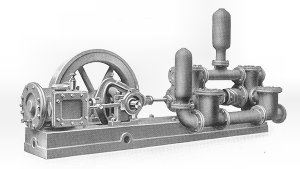 |
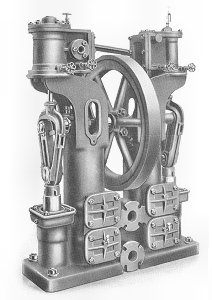 |
We are now getting into the big stuff. This
is a Double Ram Compound Steam Pump with Compound Cylinders and
Two Rams.
In one of its conformations it is said to deliver 39,980
gallons of water per hour. |
| The Premier Air Compressor or Acid Pump.
This can be used for exhausting or compressing and it should be
remembered that there were and are many industrial applications
of compressed air. |
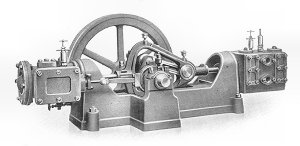 |
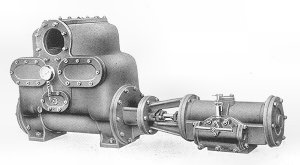 |
The Cornish Vacuum Pump. (Note the vacuum gauge). This is "for use with Surface Condensers, Vacuum Pans, Cyanide
Plants, etc.". |
| It is only quite late on in the catalogue that we
get to a relatively few pumps which recognise that electricity
has arrived. This Vertical Treble Ram Pump is
"fitted with machine cut gearing, countershaft and fast and
loose pulleys for driving from shafting, gas or oil engine or
electric motor". |
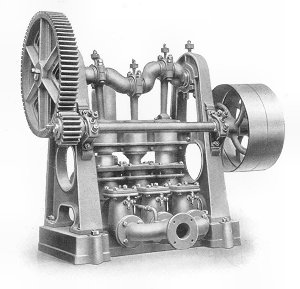 |
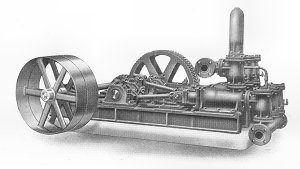 |
Likewise, this Horizontal Treble Ram pump can be
driven in the same ways. |
| And the very last pump in the catalogue is the
only one with an electric motor fitted. It is the Evans'
Centrifugal Pump with Electric Motor. |
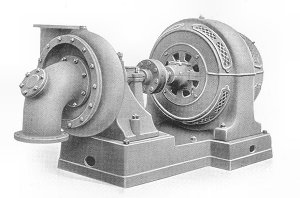 |
| The catalogue winds up with a selection of fittings such as wheel
valves, retaining valves, foot valves, strainers, junction valves, cup
leathers, hat leathers and U leathers and a variety of hoses. |
 |
|
 |
|
 |
|
Return to the
1911 catalogue |
|
Return to
the beginning |
|
Proceed to Working
at the company |
|